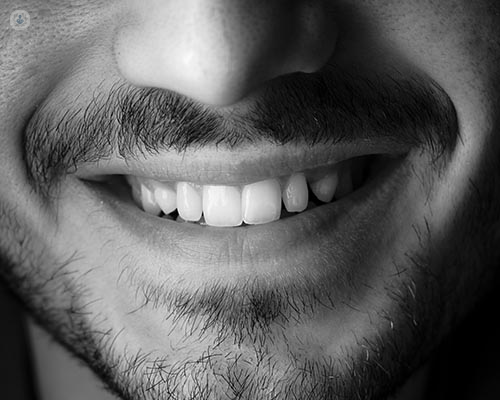Temporomandibular disorder: an expert explanation
Autore:Temporomandibular Disorder (TMD) is a complex condition that affects the jaw joint and the muscles controlling jaw movement. Often misunderstood, TMD encompasses a range of discomforts, from jaw pain and clicking sounds to difficulty chewing. Renowned consultant oral and maxillofacial surgeon Mr Ross Elledge delves into the symptoms, potential triggers, and the path towards relief for those seeking a better understanding of this prevalent yet often overlooked condition.

What is TMD?
TMD is an umbrella term for disorders related to the temporomandibular joint, which is the joint connecting the lower jaw to the skull base, along with the associated muscles. Essentially, it denotes a range of issues affecting this joint and its surrounding structures.
What are the most common symptoms of TMD?
The most prevalent symptoms reported by individuals with TMD include clicking or popping sensations in the jaw, pain that may occur within the joint or its surrounding muscles, challenges with eating leading to a preference for softer or liquid diets in advanced stages of temporomandibular disorders.
Pain, dysfunction, and difficulties, especially during wide openings like yawning or attending dental visits, are frequently observed as symptoms and signs associated with temporomandibular disorders.
What are the different types of TMD?
As previously mentioned, TMD serves as an umbrella term, encompassing a variety of issues that individuals may experience concurrently. One common problem is myofascial pain or myalgia, characterised by discomfort around the muscles used for chewing, often resulting from clenching or grinding. Patients frequently describe pain extending throughout the side of their head, accompanied by headaches.
Another issue involves internal joint derangement, where the cartilage in the joint does not move as it should, leading to clicking, popping, and joint locking. Some individuals may exhibit arthritis, involving degenerative changes in the joints, causing severe pain and functional limitations. Additionally, the psychological aspect varies among patients, with differing coping mechanisms, alternative strategies, or tendencies to catastrophise due to the perceived inability to manage the pain. In essence, the broad categories encompass internal joint derangement, arthritis or degenerative changes, myalgia or myofascial pain, and the psychological factors unique to each patient.
What are the causes for TMD?
The causes of temperamental disorders in most patients are multifaceted. Microtrauma, involving repetitive strain on the joint, plays a significant role. It's noteworthy that not everyone develops temperamental disorders despite the joint's constant use in daily activities such as eating, yawning, chewing, and talking. Habits such as clenching, grinding, nail-biting, biting objects, and excessive gum chewing can contribute to the development of temperamental disorders.
For instance, one of my patients, a competitive eater consuming a hundred chicken wings in a minute, experienced temperamental disorder issues due to her extreme eating habits. Additionally, instances of macrotrauma, such as being hit by a horse or a football impacting the face, are often reported by patients. While these events may be the apparent triggers, they are likely the final straws, with underlying factors also playing a role in the development of temperamental disorders.
What are the different treatment options for the TMD?
The majority of individuals experiencing temperamental disorders typically respond well to what we refer to as conservative management. This involves exercises, either self-directed or with the guidance of a physiotherapist, along with periods of joint rest. Additional approaches include using topical medications like ibuprofen gel and applying hot compresses. For those with myalgia or muscle pain, alternative strategies may be beneficial, such as specific medications, Botox injections into the muscles for relaxation, potential physiotherapy, and the use of bite-raising appliances—devices worn in the mouth to alleviate muscle strain.
In cases of internal joint derangement or arthritis, the initial course of action often involves joint lavage, conducted through arthroscopy, where the joint is examined, cleaned, and potentially subjected to minimally invasive treatments guided by a camera. However, a very small subset of patients may require open joint surgery, which can even entail a total replacement of the jaw joint. It is crucial to note that such extensive treatments are necessary for only a minority of patients.
How can I prevent this from happening?
If you were to suspend it, your jaw would remain motionless, causing no issues. However, daily activities such as eating, talking, and functioning require the use of our jaw. A prevalent issue, especially among those who clench and grind due to stress, is addressed through Botox treatment. I administer injections to relax the muscles, likening it to prescribing propranolol or a beta blocker for anxiety.
While it alleviates symptoms, the root cause often lies in tension and stress, leading to clenching and poor sleep habits. Emerging evidence suggests a holistic approach, considering patients' background psychology and implementing strategies to relax and reduce joint strain, can be beneficial. Referring back to my competitive eater, even lifestyle changes, such as ceasing extreme activities like consuming 100 chicken wings in a minute, can contribute to improvement.
What is the difference between TMG and TMJ?
When patients mention having TMJ, I clarify that there are two TMJs—one on each side of the head. TMJ stands for the temporomandibular joint, while TMD refers to temporomandibular disorders. TMD serves as an umbrella term, encompassing various issues such as muscle problems, joint problems, and internal joint derangement. Some individuals prefer different terminology, but I find TMD useful as it captures the diverse nature of these disorders. On the other hand, TMJ specifically refers to the joint itself, often extended to TMJ dysfunction when discussing joint-related issues.
If you would like to book a consultation with Mr Elledge, do not hesitate to do so by visiting his Top Doctors profile today.


